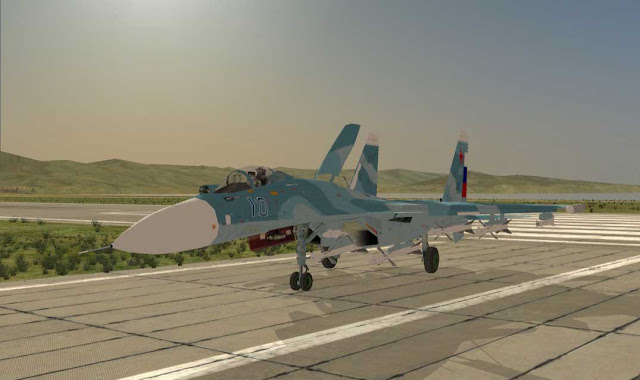This is the edited debrief of a medium rank officer of the Russian Naval Aviation, who by the time of the infamous incident was assigned to the 44rd Independent Naval Air Squadron. His name is withheld at his request.
This was played as a custom-made mission in Flaming Cliffs 3. The story line now takes us hundreds of kilometers south of the North Caucasian District, more specifically to the Black Sea. The so-called "Poti Incident" didn't make it to the press headlines, but didn't go un-noticed by the Russian leadership. Individual dots started to look like having a connection ...Nothing was out of the ordinary at Novorossiysk. A few assets of the 44rd have been hosted by the 184th Novorossiysk Coastal Defense Brigade's facilities at Novorossiysk, including the two Su-33s of the flight that I commanded that morning. Our mission was a routine patrol in which we flied over international waters in the Black Sea, following the contours of the shores of Abkhazia and Georgia.
 |
| The Novorossiysk Airbase was still under construction but it offered all the needed support and services for our sorties. |
 |
| The coast of Abkhazia seen from my cockpit and against the morning sun. |
 |
| Some 20 minutes into our flight, all chatting with my young wingman was abruptly interrupted by a Beriev A-50 that just got into a station some 40 km west of Sochi. We were unaware of this flight until it contacted us and mildly surprised to receive authentication codes that are supposed to be used in war time. The AWACs directed us to intercept and visually identify an aircraft bound to Poti. |
 |
| The adrenaline took over for a few seconds before I could kick myself up to speed with the situation. Suddenly, that radar warning receiver (RWR, the thing with the orange lights) became the center of attention. |
 |
| The vector provided by AWACs was enough to find the aircraft which turned out to be a transport. |
 |
| While we maneuvered into position, we were continuously painted by an enemy radar. We have known of this threat for weeks -it was a US frigate that has been operating in the area for a while- but right now it was more than worrisome. |
 |
| In order to visually identify the aircraft, we maneuvered closer. The transport was a C-130 from the Turkish Air Force. |
 |
| It was time to get done with this deal because we were flying on an east course and the coast of Georgia was approaching fast.It was not clear to me if the Turkish aircraft has seen us so I flew closer and put myself in front of it so he could see my "it's OK to proceed" maneuver -a climb break-away of 90 degrees or so- which I completed some 50 meters off his flight path. |
 |
| The Turkish pilot didn't rock his aircraft to acknowledge our departure but rather dropped flares frantically ... Which probably indicated that he felt threatened. In that case, the lack of evasive maneuvering was conspicuous. |
 |
| After breaking contact, our flight was locked by a long range radar and fired upon from the coast of Georgia. We suspect that the US frigate has fired a SAM at us. |
 |
| Evasive maneuvers off the coast of Georgia. |
 |
| The hostile radar didn't turn off and continued to paint us. Fearing a lock and a new SAM coming our way we put some distance from the threat, flying at very low altitude. |
 |
| We returned to our base in Novorossiysk, with more than one tale to tell. |
Commentary. Two days later, the US Navy grudgingly acknowledged firing a single SAM from the USS Simpson (FFG-56), citing a violation of Georgian sovereign waters in which the vessel was seeking harbor. The US Navy acknowledgement was accepted by the Russian Defense Ministry without any further public announcement to the international press.
 |
| Naval activity off the port of Poti. According to Russian intelligence sources, the USS Simpson was shadowing a transport ship without flag. |
 |
| The Turkish military transport was followed by the Russian AWACs until it landed at the Georgian airbase of Kutaisi. |

















1 comment:
Wow, intense. I love this series :)
Post a Comment